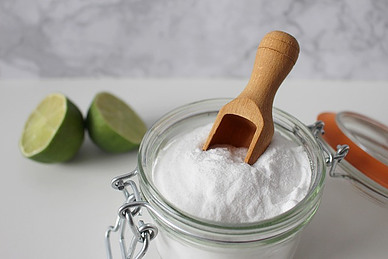You can use baking soda in the garden for many purposes: protect plants from diseases and pests, eliminate weeds, clean tools, and do soil acidity tests.
The main advantage of baking soda is its availability. You can get it in any supermarket without a pesticide card. In addition, it does not contain chemicals. This is why baking soda can be used by eco and organic gardeners.
In this article, we will share with you excellent ideas on how to use baking soda wisely in your garden and recipes for preparing preparations based on baking soda. Continue reading to learn more.
Baking Soda in the Garden Is a Universal Pesticide and Fungicide
Baking soda does not kill fungi but creates unfavorable pH conditions for their growth. In other words, it works best as a preventative but can also effectively eliminate existing fungal diseases. Always remember the old saying that prevention is better than cure.
This preparation should be applied towards the end of the day. Spraying plants in the sun could cause burns on the leaves. Also, ensure that rain is not forecast for at least 24 hours after applying the product to the plants so that it has time to work.
Baking soda works against almost all pests in the garden. If you notice aphids, thrips, mites, shield moths or whiteflies, worms, caterpillars, harmful fungi in the soil, powdery mildew, black spots on rose leaves, or rust on your plants, get rid of them with the help of this preparation:
Put a liter of water in the container and add two teaspoons of baking soda. Add one tablespoon of neem oil, but if you don’t have it, any other vegetable oil like sunflower or olive will do. Then add ten drops of dish detergent, and use organic detergent if you want a 100% organic garden. Mix well and pour into the atomizer. Do a test, spray one leaf, and leave for an hour or 2. If the leaf wilts, the solution will need to be further diluted.
You can spray tomatoes, cucumbers, zucchini, squash, melons, and beans with baking soda.
Spray the entire plant and the leaves from the top and bottom until the solution starts to drip, and let the plant dry. Repeat the application once a week. If the fungus continues to develop despite repeated applications of baking soda, consider using a stronger antifungal agent.
Baking Soda for Natural Control of Pests on Cabbage
Cabbage flies and leaf owls are the most common pests on cabbage. To get rid of them, mix baking soda with any flour in a ratio of one to one, plain white wheat flour will also work, and mix them well. Sprinkle the mixture over the cabbage. The caterpillars will eat it and die within a day or two.
Baking Soda in the Garden Can Drove Away Snails
To get rid of snails from the garden, you can use baking soda in 2 ways. The first option is to sprinkle it directly on the snails. If this procedure seems too cruel to you, sprinkle baking soda around the pots with plants or around the bed in the garden and thus block the snails’ way to the plants.
Baking Soda Against Weeds in the Garden
Eliminate weeds from the vegetable garden with baking soda. Sprinkle it directly on the weeds. The baking soda will burn the leaves, so the weeds will eventually disappear. In this way, you will not only remove the existing ones but also prevent the growth of new weeds for a while. When doing this work, be very careful that the soda does not end up on plants that you do not want to destroy.
Cleaning Garden Tools and Furniture Using Baking Soda
It is known that dirty garden tools rust more quickly, and at the same time, they also transmit diseases from plant to plant. For example, if you cut a tomato affected by blight with scissors and then a healthy tomato plant, and you do not clean the scissors in the meantime, there is a high probability that you will also infect the healthy plant. Prepare a liter of water, and add two teaspoons of baking soda and two teaspoons of dish detergent. Dip the cloth in the solution and clean garden tools, dirty plant pots, and garden furniture.
A Soil Acidity Test That Only Requires Baking Soda, Vinegar, and Water
Collect soil samples from different parts of your vegetable garden in small glass containers. Add half a cup of baking soda to half a cup of vinegar. Pour the solution into pots with soil. If the soil begins to foam, it means it is alkaline, i.e., its pH is above 7. Mix half a glass of water and half a glass of baking soda in another container. If the soil begins to foam, it means it is acidic, i.e., its pH is below 7.
Considering that baking soda is a natural agent, its effect on various pests and diseases is usually milder and slower than the effect of chemical pesticides and fungicides. For this reason, you will have to spray more often, but if you want organically grown vegetables, the effort will pay off many times over.
